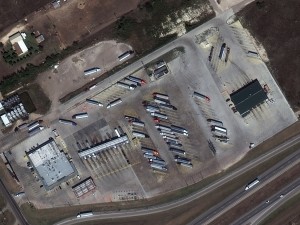I was watching the HBO series Sonic Highways recently. It chronicles the history of music in eight great American cities, one of them being Austin, Texas, the self-proclaimed “Live Music Capital of the World.” One of the central figures in this documentary is the great Willie Nelson. A pioneering musician in the outlaw country movement of the 60’s, he is an American icon and treasure, and is still going strong in his 80s. Willie is known for a lot of things, one of which being his forward thinking on environmental and food issues. I first heard about him when I was a wee sprite back in 1985 and the very first Farm Aid was held in my hometown of Urbana-Champaign, Illinois. The mega-concert was orchestrated by Willie, John Mellencamp and Neil Young, and hosted numerous other big name attractions. Its intent was to raise money for farmers in danger of losing their property through mortgage debt.
 Carl’s Corner, Texas is home to one of two plants that give us BioWillie, the other being in Salem, Oregon. I guess it is the default fuel of every Willie Nelson tour as well; he probably gets a good discount! 40-cm color image captured by WorldView-3 on October 15, 2014 and comes courtesy of DigitalGlobe. Photo enhanced by Apollo Mapping.
Carl’s Corner, Texas is home to one of two plants that give us BioWillie, the other being in Salem, Oregon. I guess it is the default fuel of every Willie Nelson tour as well; he probably gets a good discount! 40-cm color image captured by WorldView-3 on October 15, 2014 and comes courtesy of DigitalGlobe. Photo enhanced by Apollo Mapping.Well, Willie isn’t a one-trick pony, and he kept fighting the good fight, spreading the word about the need for our country to pay attention to what we’re doing to it through destructive practices, one of which being excessive fossil fuel use. In 2004, his wife bought a diesel car that she used only biodiesel to run. Biodiesels are comprised of either vegetable or animal-fat bases and can be run in any car that comes stock diesel ready. The history of biofuel way predates Willie, however. The first known use of vegetable oil as fuel happened in the mid-19th Century, four decades before the first diesel engine. In the 1930’s, a professor at the University of Brussels applied for a patent for the use of vegetable oils as fuel, and the technology started to pick up steam. While the use of this alternative fuel continued throughout the early part of the 20th Century, it wasn’t until late in the 1970’s that it became more widespread. The 1990’s saw much of Europe building plants that rely on the derivatives of rapeseed oil.
Biodiesel isn’t the only alternative fuel on the market these days. Another that has become more prevalent is E85, an abbreviation for an 85% ethanol fuel blend derived from corn, making it most popular in the Midwestern states that are the largest producers of the crop. E85 is touted for its reduced tailpipe emissions, as well as its ability to be sourced locally, therefore mitigating the carbon footprint that accompanies long-haul transportation of traditional fuels. But E85 has its critics. Some say that the use of corn as fuel drives up world food prices, though advocates of the fuel source say that most corn is not intended for human consumption. Other arguments include the use of traditional fuels in the production of ethanol, thus making attempts at production of a “cleaner” fuel not necessarily so.
And while we still have miles to go (pun intended) on finding better options for fueling our cars more efficiently, and thus reducing the impact on the environment (such as electric cars), it bodes well for the future that scientists and engineers are pushing the boundaries of thought. It appears BioWillie is here to stay, for now. In 2012, Pacific Biodiesel put a BioWillie pump in Maui, where Willie happens to reside. His fuel is still mass produced in two states, Oregon and Texas, so there is hope that the brand will stay ‘on the road again’ and again, and again…
Justin Harmon
Staff Writer


Leave a Reply